
The Republican National Convention has wrapped up, but discussion rages on about some of the tactics the NYPD used in its security operations for the week. We speak with two lawyers working on cases stemming from RNC protests. [includes rush transcript]
The Republican National Convention has wrapped up, but discussion rages on about some of the tactics the New York Police Department used in its security operations for the week. During the convention, the NYPD operated with a budget of $60 million, which is larger than all but 19 of the world’s standing armies. And they were certainly not alone. In lower Manhattan, the Multi-Agency Command Center, or MACC, was the security “nerve center,” — with some 66 separate city, state and federal agencies coordinating their work.
While the police have declared last week a success, there were a number of incidents and tactics that have come under heavy fire from civil liberties advocates and legal groups. In a moment, we will be joined by two lawyers working on cases stemming from last week’s protests. But first, we get the perspective from the police. On the last night of the RNC, I had a chance to talk with Deputy Police Chief Michael Collins. Here is some of what he had to say.
- Michael Collins, NYPD Deputy Police Chief interviewed on September 2, 2004 outside Madison Square Garden.
- Donna Lieberman, Executive Director of the NYCLU, the New York chapter of the American Civil Liberties Union.
- Marc Steier, attorney with the Mass Defense Committee of the New York City National Lawyers Guild.
Transcript
AMY GOODMAN: On the last night of the RNC, I had a chance to talk with Deputy Police Chief Michael Collins across the barricades at 30th and 8th Avenue where more protesters continued to gather as President Bush spoke inside. Here is some of what Deputy Police Chief Michael Collins had to say.
MICHAEL COLLINS: The strategy this week was to ensure that the rights of all New Yorkers and all visitors to New York were protected, and that people who needed to go to work and go about their daily lives could do so with as little interference as possible with preparations for the convention and preparations for any demonstrations that were planned, and I think overall, we accomplished that mission. Most people could get around New York as needed. Most of the demonstrations went off without incident, and when there was lawbreaking, police used minimal — minimal force in effecting those arrests. There were very few people injured on the police side and on the demonstrators’ side. With just about everyone in the crowd, or every other person in the crowd with a camera, I have not seen any video or pictures that trouble me. It looks like the police were professional and patient.
AMY GOODMAN: That was Deputy Police Chief Michael Collins on the barricades on the last night of the Republican National Convention just after President Bush addressed the convention at the Madison Square Garden a couple of blocks above where Collins was. We’re joined right now by Donna Lieberman, Executive Director of the New York chapter of the American Civil Liberties Union, and Marc Steier with the Mass Defense Committee of New York City National Lawyers Guild. Why don’t you start, Donna Lieberman, with your response to what the Deputy Police Chief had to say.
DONNA LIEBERMAN: Well, I think that the Deputy Police Chief must not have seen the videos which were aired on TV of hundreds of people being swept up for following the instructions of the police department, as to how they could have a lawful march. That happened across from Ground Zero on Fulton Street with the War Resistors’ League demonstration. It happened in Union Square, or off Union Square, on 17th Street where a group of protesters negotiated where do we march lawfully, go on the sidewalk. They went on the sidewalk and boom, they were swept up. That’s not to mention the scores of bystanders, maybe hundreds, who were swept up in the indiscriminate sweeps. Those sweeps included bystanders, press people, medics legal observers, and we believe that indeed the police department may have been targeting the green-hatted guild legal observers. Our observers from the New York Civil Liberties Union in the blue caps were not targeted. Only one received a summons that was an utter case of harassment for which we will be filing a complaint. I think we have a lot to investigate here. Indiscriminate arrests is just the tip of the iceberg. We saw a couple of incidents of violence. He must have missed the mopeds, police in plain clothes driving their mopeds into the crowd on Monday night. Then I think the huge story is about the indefinite or the prolonged detention of people who were arrested. The police bragged that they were giving DAT’s in virtually all of the cases.
AMY GOODMAN: Desk Appearance Tickets.
DONNA LIEBERMAN: Which is supposed to be the fast track to getting out on a minor offense and it took tons longer, days longer to get out on a DAT, Desk Appearance Ticket, for a disorderly conduct, than it would take on a misdemeanor charge or even a felony charge. And then, of course, there are the conditions at the pier, at Pier 57. The New York Civil Liberties Union has taken a sample of Pier 57 that was brought to us, and we’re having it analyzed for toxic chemicals.
AMY GOODMAN: Let’s talk about the scope of what happened last week. Watching the talk shows this weekend, no one might have are realized the level of the protests, as they wrapped up the significance of the week. We’re talking about the largest mass protest in the history of political conventions. We’re talking about the largest number of people arrested in a single day, over 1,000 on Tuesday, in the city’s history. The single largest number of arrests, and one of the largest in the history of this country. And overall, the number of arrests close to 2,000, more than 1,800. Let’s go to the videotape again, to Deputy Police Chief Michael Collins talking about several issues, including the conditions at Pier 57.
AMY GOODMAN: And what new technology did you bring in with the $60, million or $70 million that was spent on security?
MICHAEL COLLINS: New technology that was used in the — this week? I think it was some security things that were instituted over at the Garden, Madison Square Garden and the surrounding area. Relative to the demonstrations, I don’t know of any new technology that was unveiled, so to speak.
AMY GOODMAN: What’s going on?
MICHAEL COLLINS: It looks like they’re sending officers home due to the peaceful nature of the demonstration.
AMY GOODMAN: What about the criticism that there were many — (aside) Democracy Now!, radio and TV show) — that there were many people caught up in a dragnet, I mean, for this number of arrests, 1,700, not given warning, the police would move in very quickly from one side, the uniformed police, coming down a sidewalk, undercover cops would come up on mopeds or motorcycles, undercovers would be in front stopping a group of people from moving forward and in one swoop arresting people without the bullhorn, without arresting people.
MICHAEL COLLINS: I’m not familiar with the tactics that you are describing. I know that we are trained. We train our officers to, if possible, give a warning and give people the opportunity to disperse, and then arrest them. However, in some situations that’s impossible to do. Each situation is different and unique. And each situation, each arrest will be evaluated by the district attorney’s office and by the court.
AMY GOODMAN: Do you feel pleased with what happened this week?
MICHAEL COLLINS: I think overall, the rights of the broadcaster, the — the rights of the protesters, the rights of the people participating in the Republican Convention and the rights of all New Yorkers and all visitors to New York were pretty well defended, and upheld.
AMY GOODMAN: Deputy Police Chief, Michael Collins. We’ll talk about Pier 57 in a minute, but what about this point, Donna Lieberman, of the technology?
DONNA LIEBERMAN: Boy did we see technology. We saw old type tactics like orange netting, which is not very technosophisticated, but we also saw —
AMY GOODMAN: Explain what you mean when you say orange netting?
DONNA LIEBERMAN: The preferred arrest mechanism was to use this orange — plastic orange mesh that’s used at construction sites often to wrap people up and the police would pull it out without warning, and just grab in everybody in the path. That included press people, medics, legal observers. You couldn’t get out, except occasionally if you were able to establish press credentials. But there was also more sophisticated methodology in place and that’s video surveillance, helmets with video cameras on their heads, on them. And a massive surveillance camera, ostensibly to protect Madison Square Garden, but aimed right at the protest site, the designated area south of the Garden on Eighth Avenue. We counted, we did a survey at the NYCLU of the number of video cameras on 8th Avenue south of 31st Street in the protest area and came up with over 26 cameras. The same area on 9th Avenue only had a handful of cameras and on 7th Avenue only a handful. So, there is clearly an effort underway to videotape demonstrations, the undercover cameras were just a piece of it. At every demonstration, lawful or not, police officers were there, videotaping, and this is intimidating. It’s also raising concerns about the maintenance of political dossiers on people, which is just — harks back to the bad old days of the Red Squad and all of our FBI files or NYPD files, and is a time not so honored technique of intimidation and dirty tricks.
AMY GOODMAN: Marc Steier, would you like to expand on that?
MARK STEIER: I have to agree of the chilling effect of the video cameras all up and down the protest areas. Members of the TYRA, which is the videotapes unit of the police department, were not the only ones videotaping. Undercover police were videotaping and teams were actually shadowing a number of protesters using their first names as they passed by, how you are doing, so and so. So, very chilling behavior by the police. I don’t know about what Deputy Chief Collins saw, but I can speak for 12 to 16 hours a day on the street having seen arbitrary arrests, arbitrary filming and lawful permitted protests were being filmed extensively.
AMY GOODMAN: Now, what about the issue? I would think that many people would say it’s not as if the police were beating the protesters, they were just taking pictures of them. What’s wrong with that?
MARK STEIER: Actually, one thing is wrong with that, on Monday night, at the end of a permitted march, they allowed the Kensington Poor People’s Economic Campaign to march into the protest zone, and then started penning people in using, offensively using the metal barricades against people. I was pinned up against a light post, and there’s — there were a number of people who filmed motor scooter undercover cops ramming into the crowd with their vehicles. A very unsafe condition was created by the police department at that time, and of course, all of this has been captured on videotape not just legal observers, but the PD itself hasn’t issued any of their videotape showing the unruliness that required a whole squad of motor cops to ram into a crowd.
DONNA LIEBERMAN: I think the Kensington demonstration is an example of the Jekyll and Hyde policing that we saw. There was no permit for that march. Yet the police department agreed to — and negotiated a march route and it went on for the most part without incident. There were some problems along the course of the route, but that was an example of good policing. We saw other examples of that during the course of the week that facilitated hundreds of thousands of people, as you said, in the most sustained, prolonged voluminous demonstrations that our country has seen in the context of a convention. But at the end of the march, we saw, whether it was rogue cops or by design, and a number of police officials at the higher levels have indicated that this was — they understand that this was wrong, but it happened. You know, coming out with the metal barricades, charging the crowd and flipping people out, creating a may lay and compounding the problem by driving the mopeds driven by plainclothes officers into the crowd.
AMY GOODMAN: Let’s explain — when you say driving the mopeds by plainclothes officers. We saw this several times. The people who are protesting have no idea who these people are. They come into the crowd, driving in their mopeds often wearing Yankees jerseys.
DONNA LIEBERMAN: “Babe Ruth 3”
AMY GOODMAN: They don’t know if they’re a gang, they don’t know what’s going on. They only know they’re being plowed into.
DONNA LIEBERMAN: They’re totally intimidating. I was on my bicycle going uptown on 8th Avenue Sunday night and saw this wedge of motorcycles. I got off my bike and went onto the sidewalk. I knew who they were. But I knew who they were. When you are in a demonstration and are not monitoring the police activities and haven’t heard about these, you don’t know. People think they’re being attacked by vigilantes. It’s unfortunate that one of the police officers was hurt. I understand that he’s okay, and that’s good news. But this is the kind of tactic that needs to be investigated and exposed and addressed for future reference. You know, the RNC may be gone but protest certainly is not.
AMY GOODMAN: The issue of photographing which goes back it something called the Handschu Agreement. Can you describe what the Handschu Agreement is and why is there a problem. When can police videotape and when can’t they?
DONNA LIEBERMAN: There’s no clear answer. It’s a matter of intense dispute right now. The police maintain they can videotape anything and everything and they do it. The lawyers in the Handschu case who have been the lawyers on this case for like 20 years, have written to the court asking for limits, and complaining about the pervasive videotaping that was going on prior to the RNC. The concern about videotaping, everybody is doing it, indy media is doing it, credentialed media is doing it. The concern about government doing it, not that the government shouldn’t have access to public information, it’s that the government shouldn’t be maintaining political dossiers on people. That’s what they did during the McCarthy period. That’s what they did during the civil rights and anti-war movements. They can’t do it now, because what they do when they have the political dossiers is selectively release the information, selectively use half-truths to target political opponents of the administration. And it’s important that we put a lid on this pervasive police intimidation tactic, which by the way now is also coupled with another tactic from the McCarthy period. It’s the law enforcement stakeouts. A number of political activists have reported that they were staked out. Jennifer Flynn was home in New Jersey at her parents’ house over the weekend, and there were clearly identifiable police vehicles staking her out in the suburbs.
AMY GOODMAN: Who is Jennifer Flynn?
DONNA LIEBERMAN: Jennifer Flynn was one of the leaders of the, Still We Rise Coalition that organized the Monday afternoon demonstration. She participated with me, with Chris Dunn in negotiations with the police how to do it lawfully. Other people have been reported that they have been trailed by the police in obvious 1950’s kinds of ways. So this regression to the bad old days is a serious problem, and we’ll be addressing it in litigation, in city council hearings, and in the public, because we have to put an end to it.
AMY GOODMAN: I want to go back to Deputy Police Chief Michael Collins talking about the conditions in which people were kept.
AMY GOODMAN: … Pier 57 and the complaints that it hasn’t been used for human beings for quite a while. I was speaking with a Transit Union worker who said there was a big fire in 1994, very serious issues of asbestos, asbestos abatement not fully done, and a lot of people who were put there, not for fifteen minutes or an hour, but for hours and days, that this was not a safe facility to be in.
MICHAEL COLLINS: The New York City Police Department would not put prisoners, because when you put prisoners in an unsafe location, you put prisoners there, we have to put our employees there. We would not expose our employees nor the prisoners to anything unsafe. The air on that pier was tested as recently as I believe Tuesday or Wednesday night. So, Tuesday night it was found to be safe. The place was clean and sufficient for what its purpose was designed for. And inspected and cleaned after every use. It was not designed to keep people there for days. And in fact nobody stayed there for days. People were processed there, and the longest that somebody stayed on the pier was eight to ten hours, tops, and then they wound up in the courts. They were not kept there. That was not designed to keep them there for days.
AMY GOODMAN: Deputy Police Chief Michael Collins. Marc Steier, of the Mass Defense Committee of New York City National Lawyers Guild, your response.
MARK STEIER: We have dozens of complaints from people who were kept at Pier 57, that the conditions there were intolerable. They have rashes, persistent coughs, asthmatics have attributed their stay there to attacks. We actually have a sample that’s being tested right now of both the wall and the floor of this bus depot. It hasn’t been used for, you know, years, except by buses. This is a mistake by Deputy Chief Collins. I don’t think he saw the conditions there at Pier 57. I hope on behalf of the workers that had to be there as long as they did along with protesters, that they do actually come forward and admit that this was a grave mistake.
AMY GOODMAN: Donna Lieberman.
DONNA LIEBERMAN: You know, the city made clear in the months leading up to the convention that they were well prepared for up to 1,000 arrests a day. They didn’t have as much as they said that they were prepared for. Nonetheless, people were thrown into this possibly toxic, certainly filthy facility, and people were not processed for days. So, we have to ask the question, if they were so well prepared, was there a malfunction or was it by design?
AMY GOODMAN: Chief Collins said that wasn’t the city’s fault, that was something to do the state, Albany not being able to process the fingerprints?
DONNA LIEBERMAN: Does the word baloney fly? We were told that in fact there wasn’t a problem with the NICIS, that’s the state database of fingerprints. It’s important for us that we bring litigation challenging these detentions partly to vindicate the rights of the individuals, but also partly to find out from sworn testimony, what happened, what went wrong, who was responsible, and why.
MARK STEIER: In fact, today a judge will be having a hearing on what amount the city owes in contempt charges for having held people up to 60 hours, 70 hours.
AMY GOODMAN: What about that issue, right before President Bush addressed the RNC, the judge ruling that if these hundreds of demonstrators at that moment that had been designated were not released, that there would be a fine of $1,000 per protester held. Implication of all of this is that the protesters were just being held through the week to hold them past President Bush’s speech?
DONNA LIEBERMAN: I think it was the Tuesday night — the Tuesday crowd of arrestees that was at issue. That’s 1,000 people or so, several hundred of whom were illegally arrested. It may well be. I think that we’re going to find out in the course of litigation whether in fact that was the plan, but you know, virtually everybody was released by, you know, the end of the speech. So, the pieces of the puzzle just seemed like they’re coming together.
MARK STEIER: In terms of policing, this the same sort of thing that was seen at the FTA protests in Florida. They arrested people and tried to hold them as long as possible with the connivance in Florida of the courts. I remember hearing a quote from someone in the police department that that was in fact a tactic that would be used here.
DONNA LIEBERMAN: I think one thing we just have to remember as we criticize …
AMY GOODMAN: We’re wrapping up.
DONNA LIEBERMAN: … as we criticize what the police did, and they made a number of errors and violated people’s rights in a number of ways, that hundreds of thousands of people did get to protest the administration’s policies in a peaceful way. The protesters were overwhelmingly peaceful, contrary to what Chief Kelly would have had us believe in the days and weeks and months leading up to the convention.
AMY GOODMAN: On that note, I want to thank you both for being with us. Donna Lieberman, Executive Director of the New York chapter of the American Civil Liberties Union, and Marc Steier, attorney with the Mass Defense Committee of the New York City National Lawyers Guild. Thank you.


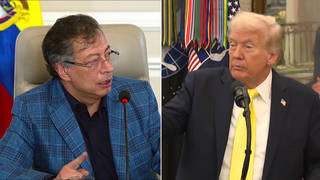
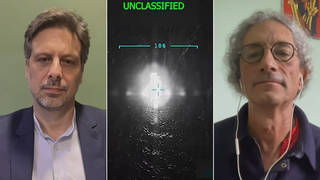
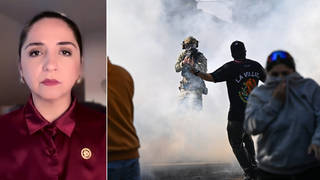





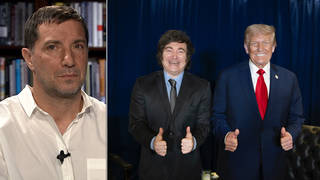
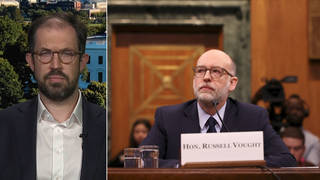
Media Options